
Maharaja Ranjit Singh was one of the most enlightened Maharajas of the Sikh empire. During his rule, people of different castes, cultures and faiths worked hand-in-glove. There was no death penalty, no matter what. He created a secular kingdom, even though he was a Sikh. His motto came straight from the teachings of the Guru: “All will be free here.” The kingdom gradually grew expansive and prosperous. It stretched from Peshawar to New Delhi and was a land which flourished with literacy, knowledge, art, music and poetry. The Moguls who propagated Islam before had banned all of that, but under the rule of Maharaja Ranjit Singh, these disciplines flourished again,
creating a renaissance. But that was a particular time where a single man could rule with values and with a vision. Today, such peaceful, secular kingdom is no longer possible. Yet, as Sikhs, everyday, we say Raj Karega Khalsa, translated as- the Khalsa will rule and all will be safe in its fold. However, the complete saying goes by- ‘Raj Karen’s Khalsa, Aki rage na koi’
What does this mean today? How can it become real?
First, we have to recognize, in a Khalsa Raj, from its beginning and in its design, everybody is an equal part of it. Discriminatory behavior on the basis of caste/class system, racism, or misogyny, have to be abandoned. When we Sikhs talk of humanity – we say Sarbat – it means all. In reality, we should reach out to strive to make sure everybody is included in this Raj and no one is left behind. In order to manifest this Raj, we need to bring Sarbat to the forefront.
Our Sikh values are universal. Therefore, our behavior has to be universal and always for the Sarbat. When we each live these values, it directly goes to the hearts of people around us.
Our pillars are “Kirit Karna” Working hard honestly and without exploitation. “Vand Chakna” Sharing equally with others and “Naam Japna” of calling upon the Divine in ourselves and in each other. These pillars lend themselves naturally to this democratic Raj.
The Khalsa will not succeed just because of how we look. I don’t mean that we do not wear turbans or bana. What is meant is that our success is not dependent upon our skin color or creed or even our turbans but in fact, our success will rely on our demeanor. Our unique look will then create the association, “Those turbaned people are like this: “They embody nobility with compassion, dignity, justice, and grace. They can serve me.” And then it will be said with appreciation.
In that way, each Sikh becomes a unique ambassador of Guru Nanak’s mission. Each and every single one of us.
We have to understand, from the time of Guru Nanak through Guru Gobind Singh, common men and women were instruments of the Guru’s word. Common people served as the vessels to bring the Guru’s teachings to the world around them.
The interesting thing about a modern-day Raj – it is not a fiefdom, or a serfdom. A modern-day Raj captures people’s attention by tapping into their thoughts. It is not, “I conquered you.” They come and they embrace us. It is leadership of the heart and mind. Because, in the space of darkness, we bring light. And all who come, come freely and add their light to the fold making the whole world brighter.
Nobility is not about wealth or power or status. Ultimately, it is a virtue and a way of life. The Gurus asked us to embody that consciousness and then share with others. Thus, it becomes our utmost responsibility to carry forward the teachings of our Gurus and create a land as dreamt and imagined by them. Therefore, the duty of taking forward the legacy is now entrusted upon our shoulders.





